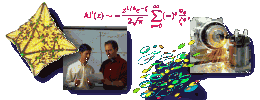|
 |
 |
|
 |
||
| Up |  |
|
 |
Finding and Quantifying Protein Monomeric Structural Pseudo-SymmetryTodd J. TaylorLaboratory of Molecular Biology, Molecular Modeling Section, National Cancer Institute Tuesday, April 24, 2012 15:00-16:00, It is well known that protein complexes are often symmetric, made from multiple copies of non-symmetric monomers arranged symmetrically. It is also the case, but perhaps less well known, that many single protein chains consist of repeating units of similar structure arranged in a symmetric manner. Some examples are TIM barrel structures with 8-fold rotational symmetry, beta-blade propellers (rotational symmetry), alpha-alpha super-helices (screw symmetry), and leucine-rich repeat horseshoe-shaped structures. We are interested in the function and evolution of symmetric protein chains. In order to amass a data set to study, we have created an automated procedure to identify such chains, to identify the type of symmetry, and count the repeats. The chief technical difficulty with such a procedure is that the structural repeats are not all exactly the same (this is not perfect crystallographic symmetry, hence the 'pseudo' in the title of this talk). Repeats can differ considerably in a structure that a human expert would still classify as symmetric. I will talk about how to test for symmetry, how to quantify 'degree of symmetry', and how to count repeats. I will also discuss the results of applying the procedure to the whole known universe of protein structures in a kind of symmetry survey. Speaker Bio: Dr Taylor obtained his Bachelors Degree in Physics from the University of California at Berkeley and subsequently worked at the Protein Structure Prediction Center at Lawrence Livermore Lab. He received a PhD in Computational Biology from George Mason University in the group of Prof Iosif Vaisman applying techniques from computational geometry to protein structure analysis. He went on to an NRC Postdoc at NIST, and is currently a CRTA Postdoc at the National Cancer Institute. His research focuses on protein structure characterization, prediction, and structure-function relationships.
Contact: B. Cloteaux Note: Visitors from outside NIST must contact Cathy Graham; (301) 975-3668; at least 24 hours in advance. |